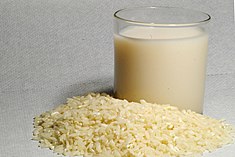Rice milk is a plant milk made from rice. Commercial rice milk is typically manufactured using brown rice and brown rice syrup, and may be sweetened using sugar or sugar substitutes, and flavored by common ingredients, such as vanilla.[3] It is commonly fortified with protein and micronutrients, such as vitamin B12, calcium, iron, or vitamin D.[3][4]
 A glass of rice milk next to some rice | |||||||||||||||||||||||||||||||||||||||||||||||||||||
| Nutritional value per 100 g (3.5 oz) | |||||||||||||||||||||||||||||||||||||||||||||||||||||
|---|---|---|---|---|---|---|---|---|---|---|---|---|---|---|---|---|---|---|---|---|---|---|---|---|---|---|---|---|---|---|---|---|---|---|---|---|---|---|---|---|---|---|---|---|---|---|---|---|---|---|---|---|---|
| Energy | 195 kJ (47 kcal) | ||||||||||||||||||||||||||||||||||||||||||||||||||||
9.2 g | |||||||||||||||||||||||||||||||||||||||||||||||||||||
| Sugars | 5.3 g | ||||||||||||||||||||||||||||||||||||||||||||||||||||
| Dietary fiber | 0.3 g | ||||||||||||||||||||||||||||||||||||||||||||||||||||
1.0 g | |||||||||||||||||||||||||||||||||||||||||||||||||||||
0.3 g | |||||||||||||||||||||||||||||||||||||||||||||||||||||
| |||||||||||||||||||||||||||||||||||||||||||||||||||||
| Other constituents | Quantity | ||||||||||||||||||||||||||||||||||||||||||||||||||||
| Water | 89.3 g | ||||||||||||||||||||||||||||||||||||||||||||||||||||
| †Percentages estimated using US recommendations for adults,[1] except for potassium, which is estimated based on expert recommendation from the National Academies.[2] | |||||||||||||||||||||||||||||||||||||||||||||||||||||
History
editThe exact origin of rice milk is uncertain. In 1914, Maria M. Gilbert gave a recipe for rice milk in her book Meatless Cookery, which was the earliest known use of the term.[5] In 1921, the first rice milk factory was built by the Vita Rice Products Co., launching Vita Rice Milk the same year in San Francisco, California.[6] In 1990, Rice Dream was launched by Imagine Foods of Palo Alto, California in Tetra Pak cartons, becoming the first widely popular rice milk.[7]
Nutrition
editRice milk (unsweetened) is 89% water, 9% carbohydrates, 1% fat, and contains negligible protein (table). A 100 ml reference amount provides 47 calories, and – if purposely fortified during manufacturing – 26% of the Daily Value (DV) for vitamin B12 (table). It also supplies calcium (12% DV; fortified) and manganese (13% DV; fortified) in moderate amounts, but otherwise is low in micronutrients.
Safety in young children
editBecause of arsenic levels in rice, the United Kingdom's Food Standards Agency recommends that rice milk should not be given to children under 5 as a replacement for breast milk, formula milk or cow's milk.[8]
Comparison to dairy milk
editRice milk contains more carbohydrates when compared to cow's milk (9% vs. 5%), but does not contain significant amounts of calcium or protein, and no cholesterol or lactose.[9][10] Commercial brands of rice milk are often fortified with vitamins and minerals, including calcium, vitamin B12, vitamin B3, and iron.[3][9] It has a glycemic index of 86 compared to 37 for skim milk and 39 for whole milk.[11]
Rice milk may be consumed by people who are lactose intolerant, allergic to soy or milk.[3] It is also used as a dairy substitute by vegans.[3][12]
Commercial brands
editCommercial brands of rice milk are available in various flavors, such as vanilla, as well as unflavored, and can be used in many recipes as an alternative to traditional cow milk.[3]
Preparation
editRice milk is made commercially by pressing the rice through a grinding mill, followed by filtration and blending in water.[4][13] It may be made at home using rice flour and brown rice protein, or by boiling brown rice with a large volume of water, blending and filtering the mixture.[4]
Environmental concerns
editRice paddies require substantial water resources, and may enable fertilizers and pesticides to migrate into contiguous waterways.[14][15][12] Bacteria inhabiting rice paddies release methane into the atmosphere, emitting this greenhouse gas in quantities greater than other plant milks.[14][15]
Rice milk production uses less water than dairy milk and almond milk, but considerably more than soy milk or oat milk.[12]
Gallery
edit-
A cup of amazake
See also
editReferences
edit- ^ United States Food and Drug Administration (2024). "Daily Value on the Nutrition and Supplement Facts Labels". FDA. Archived from the original on 2024-03-27. Retrieved 2024-03-28.
- ^ National Academies of Sciences, Engineering, and Medicine; Health and Medicine Division; Food and Nutrition Board; Committee to Review the Dietary Reference Intakes for Sodium and Potassium (2019). "Chapter 4: Potassium: Dietary Reference Intakes for Adequacy". In Oria, Maria; Harrison, Meghan; Stallings, Virginia A. (eds.). Dietary Reference Intakes for Sodium and Potassium. The National Academies Collection: Reports funded by National Institutes of Health. Washington, DC: National Academies Press (US). pp. 120–121. doi:10.17226/25353. ISBN 978-0-309-48834-1. PMID 30844154. Retrieved 2024-12-05.
- ^ a b c d e f Meagan Bridges (1 January 2018). "Moo-ove over, cow's milk: The rise of plant-based dairy alternatives" (PDF). Practical Gastroenterology, University of Virginia Medical School. Retrieved 30 January 2020.
- ^ Shurtleff, William; Aoyagi, Akiko (2013). History of Soymilk and Other Non-Dairy Milks (1226-2013). Soyinfo Center. p. 6. ISBN 9781928914587.
- ^ Shurtleff, William; Aoyagi, Akiko (2013). History of Soymilk and Other Non-Dairy Milks (1226-2013). Soyinfo Center. pp. 6, 241. ISBN 9781928914587.
- ^ Shurtleff, William; Aoyagi, Akiko (2013). History of Soymilk and Other Non-Dairy Milks (1226-2013). Soyinfo Center. p. 9. ISBN 9781928914587.
- ^ "Arsenic in rice". Food Standards Agency. 18 September 2018.
- ^ a b "Beverages, rice milk, unsweetened", United States Department of Agriculture, Agricultural Research Service.
- ^ "Milk, whole, 3.25% milkfat, with added vitamin D", United States Department of Agriculture, Agricultural Research Service.
- ^ Atkinson, Fiona S.; Foster-Powell, Kaye; Brand-Miller, Jennie C. (2008-12-01). "International Tables of Glycemic Index and Glycemic Load Values: 2008". Diabetes Care. 31 (12): 2281–2283. doi:10.2337/dc08-1239. ISSN 0149-5992. PMC 2584181. PMID 18835944.
- ^ a b c Guibourg, Clara; Briggs, Helen (2019-02-22). "Which vegan milks are best for the planet?". BBC News: Science and Environment. Retrieved 2019-09-04.
- ^ Courtney Subramanian (26 February 2014). "Milk-off! The real skinny on soy, almond, and rice". Time. Retrieved 30 January 2020.
- ^ a b Annette McGivney (29 January 2020). "Almonds are out. Dairy is a disaster. So what milk should we drink?". The Guardian. Retrieved 30 January 2020.
- ^ a b Poore, J.; Nemecek, T. (31 May 2018). "Reducing food's environmental impacts through producers and consumers". Science. 360 (6392): 987–992. Bibcode:2018Sci...360..987P. doi:10.1126/science.aaq0216. ISSN 0036-8075. PMID 29853680.